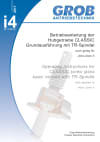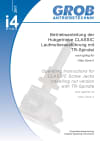Classic Screw Jack: Discover Grob's Tailor-Made Solutions
The Classic Screw Jacks (MC) are available in a total of 14 different sizes. Each of these sizes are available in both a basic version (lifting spindle) and a travelling nut version (rotating spindle and running nut). The load capacity varies depending on the size and can range from 5 kN to an impressive 2000 kN.
Here are three reasons why GROB’s Classic screw jacks are a perfect fit for your project:
-
done
Cost savings due to 70% less energy consumption *
-
done
Standard gearboxes provide greater safety due to self-locking
-
done
Low installation effort

Classic screw jacks in basic version
Spindle drive systems in their basic version are a drive solution where the lifting movement is executed by a non-rotating spindle. The spindle is guided axially through the drive system, preventing any twisting of the spindle. Overall, basic spindle drive systems provide a reliable means of linear motion control with high precision, load capacity, and low maintenance effort.
The basic version is mainly used when, in the retracted state, the spindle must not block the installation space.

Classic screw jack in travelling nut version
The classic screw jack in traveling nut version is a drive solution in which the lifting movement is performed by a traveling nut on a rotating spindle. The spindle is fixed axially in the lifting drive.
The spindle lift drive with a traveling nut is particularly used when there is no more space behind the gearbox for a returning spindle. In addition, this version offers the possibility of using larger spindles, as these do not have to travel through the gearbox. This means that the gearbox can be dimensioned normally, even if the spindle has to be enlarged for reasons of buckling safety.
Unbeatable Advantages of a Screw Jack from GROB
Custom Configuration
Thanks to the modular design principle, our classic screw jacks can be configured as needed, ensuring the perfect screw jack for any application.
Low-Effort Installation
The minimal installation effort stems from the system solution, resulting in reduced labor hours during assembly. The plug-and-play-solution ensures that spindle lift drives, including motors, bevel gearboxes, cardan shafts, and other components, can be delivered as a unified system and integrated directly at the application site.
Specialized Mounting Option
This enables adaptable integration into diverse systems and designs, catering to the specific requirements of your respective application.
In comparison
Other Screw Jacks
✖ Longer delivery times
✖ Custom solutions not available from quantity 1
Screw Jacks from GROB
✓ Customizable individual solutions
✓ 2-3 week delivery time for standard versions
✓ Support with your dimensioning
Success Stories: How GROB's Classic Screw Jacks are transforming the industry
Offshore Wind Farms
Have you ever wondered how much the massive nacelle of an offshore wind turbine weighs? It's well over 200 tons, equivalent to the weight of 6 fully loaded semi-trailer trucks. You can easily imagine that such gigantic masses cannot be moved with conventional lifting equipment. A specialized solution is required here. Learn what that solution looks like here.

Screw Jacks and King Charles - What they have in common
Screw jacks in Australia: When the Anglo-Australian Telescope (AAT) was ceremoniously inaugurated by the then-Prince Charles on October 16, 1974, at the Siding Spring Observatory in Australia, GROB Antriebstechnik GmbH was still a small artisanal enterprise. At that time, no one foresaw the connection that would later emerge. Click below to learn how the connection with GROB came about.

Operating instructions

Classic Screw Jack in Basic Version

Classic Screw Jack in Travelling Nut Version
Click here for accessories:
FAQs about Screw Jacks
What's a screw jack?
A spindle lifting drive is a combination of a spindle (screw) and a nut (worm gear or traveling nut) that converts rotational motion into linear motion through a worm gear drive.
What's the difference between the basic version and the travelling nut version?
Basic Version: The spindle itself performs the axial movement.
Traveling Nut Version: The spindle remains stationary in space but rotates. The nut then moves up and down on the spindle.
What are the main/general differences between cubic, classic, HMC, KH?
- Cubic & Classic: primarily external differences. A matter of personal preference regarding which one is preferred. Performance data is nearly identical.
- HMC: Standard up to 3000 rpm input speed, with oil filling and cooling fins - explicitly higher dynamic load capacity.
- KH: explicitly high dynamic capability, but load capacity decreases to a maximum of 90 kN.
What's the efficiency of worm gear drives?
- Standard gearboxes with standard trapezoidal threads achieve efficiencies between 25-35%.
- Increasing the pitch makes the thread slip more easily, thus increasing efficiency.
- The combination with a ball screw can also achieve an efficiency of up to 50%.
- Best combination: bevel gear lifting drives with ball screws, which achieve over 80%.
How can one best implement a position query for a screw jack?
For continuous monitoring, rotary encoders can be mounted on the motor or the worm shaft.
If only the end positions are relevant, limit switches can be used to query the desired end positions.
In hydraulic cylinders, we also often use potentiometers, which then return a certain resistance value that can be read out by the controller.
What's the difference between a rotation prevention and a spindle travel limiter?
The confusion sometimes arises because in both cases, there's an additional element at the back of the spindle.
- The spindle travel limiter is merely a ring on the thread that prevents the spindle from falling out.
- The rotation prevention additionally prevents the spindle from twisting.
How can the rotation prevention be implemented?
Customer side: The customer bears the load, preventing it from twisting. If the spindle is then attached to the load, it also cannot twist.
Gear side (product itself has a prevention rotation): We either use a groove running completely through the spindle with a corresponding key as a counterpart. Alternatively, a square block can be screwed onto the back of the spindle, and the protective tube is designed as a square tube.
Can screw jacks also be operated with a duty cycle above 20%?
The specification '20% duty cycle per hour' is always associated with a certain power consumption at the gear unit. Therefore, if the permissible power value is not exceeded, less heat is generated, and the gear unit requires less time to cool down. This allows achieving more than 20% duty cycle.
Can screw jacks units also be used in the food industry?
Yes, screw jacks can be manufactured entirely in stainless steel and equipped with food-grade grease approved according to H1 standards.
What materials are used in screw jacks?
The housing is made of aluminum die-casting or gray cast iron, the spindle, protective tube, and worm shaft are made of steel, while the worm wheel or travelling nut are made of a bronze alloy. Additionally, there are many variants.
Can I attach my own motor to the screw jack?
Yes, with motor adaptors, motors or geared motors can be flexibly attached. You decide whether you want to provide the motor yourself or if GROB takes care of it.
Can a screw jack also be adjusted with a handwheel?
Yes. A lifting gear unit can be operated with any rotary drive, whether electric, mechanical, or manual.
What does the maximum stroke length of spindle gear units depend on?
When under compression, typically buckling is the limiting factor. Under tension, it's either the availability of raw material (rods commonly available up to 6m) or the critical bending speed (in the case of the travelling nut version). For larger strokes, the spindle can also be made in multiple parts.
Why are motors with dual brakes used?
In applications with high safety requirements, two independently acting holding mechanisms may be required. This could be dynamic self-locking + motor brake or, alternatively, an independently switchable dual brake on the three-phase motor.
Can a three-phase brake motor also be equipped with a 24V brake?
Yes. Common voltage types are 24 VDC / 230 VAC / 400 VAC. Additional voltages in both direct and alternating current ranges are available upon request.
How fast does a three-phase motor rotate?
A three-phase motor rotates depending on the mains frequency. The higher the frequency, the faster the motor rotates. Rated speeds at 50 Hz are as follows: for 2-pole motors, 3000 rpm; for 4-pole, 1500 rpm; for 6-pole, 1000 rpm; for 8-pole, 750 rpm.
What lubricants can be used for screw jacks?
Lubricating grease of NLGI grade 1 or 2, suitable for heavily loaded sliding and rolling bearings. Compatibility with the existing lubricant must be ensured. It's crucial whether the grease is mineral or synthetic-based.
When should the screw jack be re-lubricated?
It depends on the operating cycle and conditions. Typically, every 500 double strokes.
How much lubricant does a screw jack require?
The lubricant quantity depends on the size and type of the gear unit. You can find specific data in our general catalog. Here's an example for our cubic screw jacks: General Catalog 2023 (grob-antriebstechnik.de)
What stroke lengths are available for a screw jack?
0 - 6000 mm in the standard range. Lengths over 6 m are also possible for special applications, but then with a multi-part spindle. Gradations can be made in the millimeter range.
What rotational speed can a screw jack be operated at?
Grease lubrication in the gearbox: up to 1500 rpm; >1500 rpm to 3000 rpm flow grease or oil lubrication.
What limit switches can be installed on a screw jack?
You can install mechanical, magnetic, or inductive limit switch solutions. Preparation for custom sensors is also possible. Please note that it's not possible to implement end position detection on travelling nut version screw jacks.
What loads can a screw jack lift?
For detailed information, refer to the beginning of each screw jack chapter in our catalog. Here's an example for cubic screw jacks: General Catalog 2023 (grob-antriebstechnik.de)
In what mounting position can a screw jack operate?
For grease-lubricated screw jacks, the mounting position can be freely chosen. For oil-lubricated screw jacks, the orientation of the ventilation must be considered.
Can a screw jack be overloaded?
The manufacturer's rated load capacity should not be exceeded. However, screw jacks typically have safety factors ranging from 1.5 to 2.5 times the rated load.
Can a screw jack be operated in the overload range?
Temporarily possible, however, this results in a significantly reduced lifespan.
Can the lifespan of screw jacks be calculated?
Yes, for screw jacks with ball or roller screw mechanisms, a lifespan can be calculated. However, for trapezoidal screw mechanisms, lifespan calculation is not possible. More information on the calculations can be found here.
What power is a screw jack operated with?
The required power depends on the load and lifting speed. A 30% reserve to the required power is recommended for the drive. The screw jack should be operated within the maximum specified parameters, which depend on the version and size. You can find exemplary power limits for cubic screw jacks here: General Catalog 2023 (grob-antriebstechnik.de)
How large is the safety margin in screw jacks, and can it be altered?
The safety margin can be increased or reduced. If reduced, it's important to ensure that block drive is always prevented during operation of the system.
What is a block drive?
A block drive describes the execution of the lift against a fixed stop. In this process, the lifting element is 'blocked' by the fixed counterpart.
How can a block drive be avoided?
The driving element, usually a three-phase motor, doesn't stop automatically but needs a signal for shutdown. This signal can be generated through limit switches, encoders, potentiometers, or other displacement-monitoring components.
Can lifting elements withstand a block drive?
Mechanical drives are very sensitive to movement against fixed stops. Depending on the force of the motor, a block drive typically results in damage to the spindle-nut system.
When do you use a ball screw spindles in screw jacks?
Ball screw spindles make sense when:
- The power consumption is too high in combination with trapezoidal screw spindles
- A higher lifting speed is desired
- A higher precision is desired
What axial play is permissible in a screw jack?
The axial play of a trapezoidal screw spindle typically ranges from 0.1 to 0.3 mm. When the axial play reaches 1/4 of the trapezoidal profile, replacement of the trapezoidal screw nut is recommended.
Can a screw jack unit withstand lateral forces?
Although lateral forces significantly reduce the lifespan of screw jacks, there are certain limits within which lateral forces can be absorbed. You can find relevant information here: General Catalog 2023 (grob-antriebstechnik.de)
What is the difference between a standing and a rotating spindle?
The standing spindle creates relative motion through the rotating worm wheel, while the rotating spindle generates relative motion for the travelling nut. The advantages and disadvantages depend on the space constraints of your lifting system.
Are there different gear ratios available for screw jacks?
Yes, each size (regardless of the screw jack type) offers 2x reduction stages (-> Normal and Slow). The exception is bevel gear screw jacks. Here, gear ratios of 1:1, 2:1, and 3:1 are possible.
What is meant by spindle extension?
Spindle extension defines a dimension that provides a certain extra length compared to the standard when in the retracted state. For example: You only need an effective stroke of 100mm, but there's a distance of 400mm to cover between the start of the stroke and the gearbox. Then we extend the spindle by 400mm, so when fully extended, you reach a total of 500mm.
What options for spindle mounting (head variants) are available for spindle drives?
For the spindle end, the standard range offers options including threaded end, articulated head, ball joint head, flange plate, bearing flange plate, and pin. You can find corresponding dimensions in the General Catalog 2023 (grob-antriebstechnik.de)
Is a screw jack suitable for outdoor use?
Yes, appropriate protection can be achieved through painting or the use of stainless materials.
How can one achieve synchronous operation with multiple lifting elements?
- Electronic bridge: If each lifting element of the system is driven by a motor, electronic synchronization can be achieved through encoders.
- Mechanical linkage: More cost-effective and fail-safe are cardan shafts and bevel gearboxes, which can connect all lifting elements of a system together.
Is it possible to replace a hydraulic cylinder with a screw jack?
Yes, the functions of 'lifting' and 'moving' can be performed by any mechanical lifting element.
What is meant by a piston tube version?
This version uses an additional tube to protect the spindle, which sits on the travelling nut. The piston tube version thus describes a lifting cylinder that has been modified based on a sscrew jack.
When do I need an oil version, and what information about it is important for the customer?
The following points necessitate an oil version:
- Use in explosive atmospheres with gas. A mandatory ATEX questionnaire is required.
- Input speed at the worm shaft ranging from 1500 rpm to 3000 rpm.
What structural changes are there in the gearbox between ball screw drive and trapezoidal screw drive (outer dimensions)?
In the case of the travelling nut version, only the nut connection dimensions change. In the basic version with the ball screw spindle, it may occur that the bearing cover is raised to accommodate the ball screw nut in the gearbox.
Are there also stainless steel versions available?
Yes, the use of stainless steel materials is a common practice for environments with aggressive media.
How does a safety nut SFM work and when is it useful?
In standard operation, the SFM runs load-free with the main nut. If the main nut fails, the SFM takes over the load. A stroke can then be performed to shut down the system. Additionally, the SFM is also used as a reference nut for wear measurement.
What options are there to protect the gearbox from external dirt?
The spindle can be protected by folding bellows or spiral protective sleeves.
What is the function of a rotation prevention?
It prevents rotation of the spindle. If a translational spindle were to rotate, linear motion would no longer be possible.
What is the function of a travel limiter?
A travel limiter (AS) prevents the spindle from accidentally falling out in the basic version. It is not intended as a mechanical end stop.
Can the products also be used in ATEX areas?
Yes, screw jacks and MINI cylinders can be used within certain limits for ATEX zones as well.
You can find us here
Eberhard-Layher-Straße 5-7
74889 Sinsheim-Steinsfurt
























